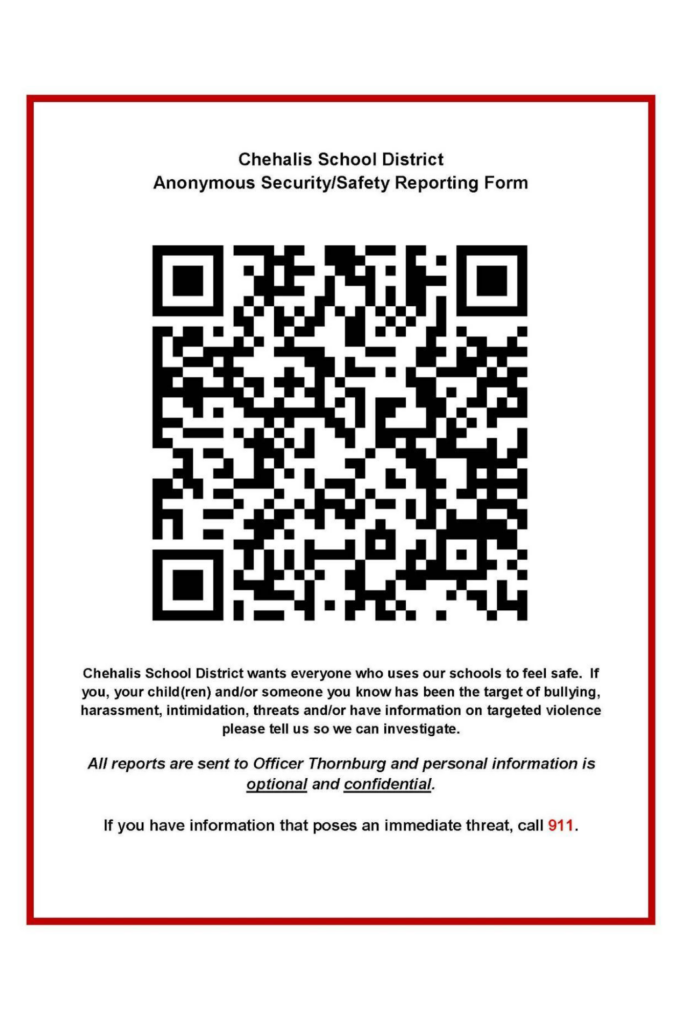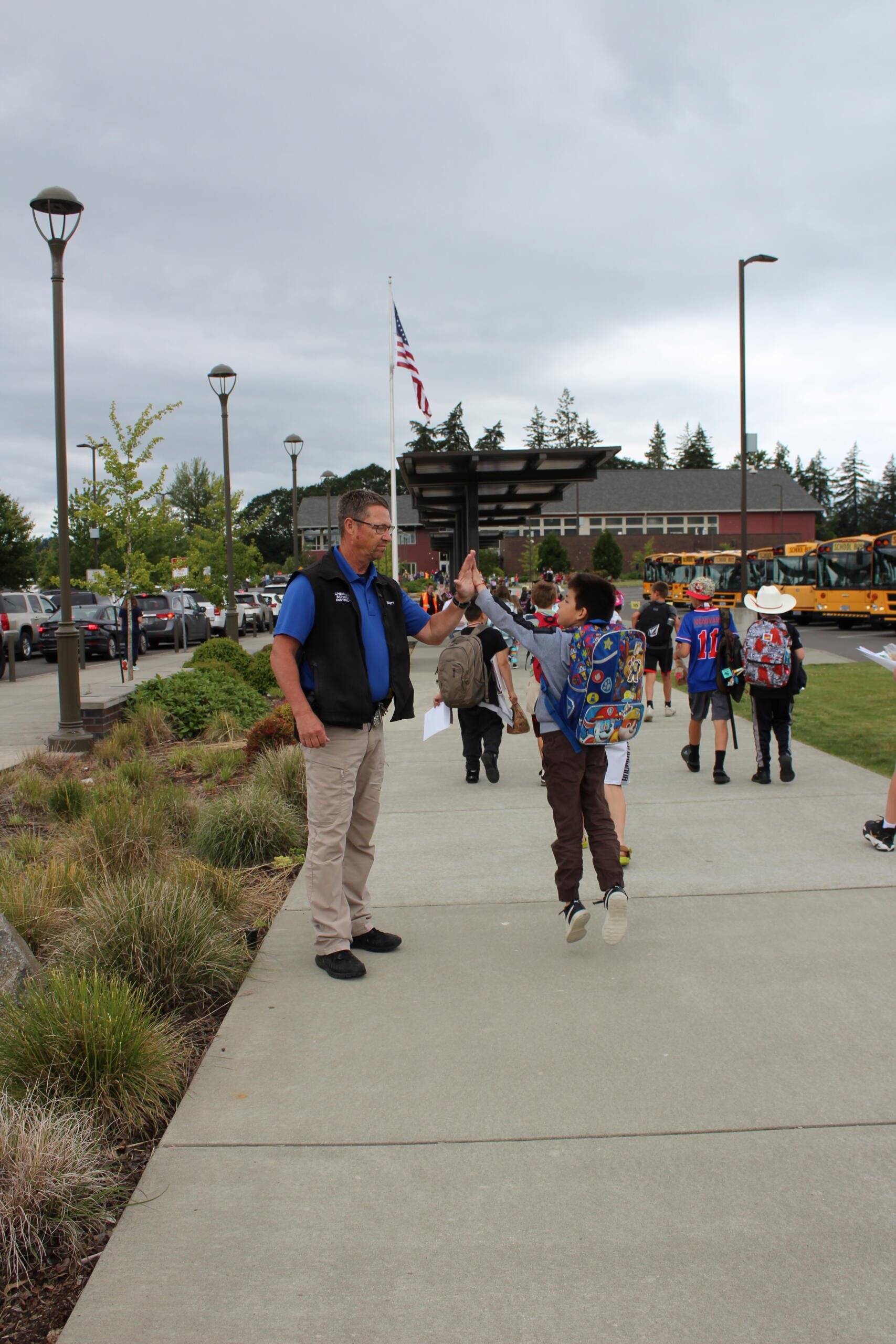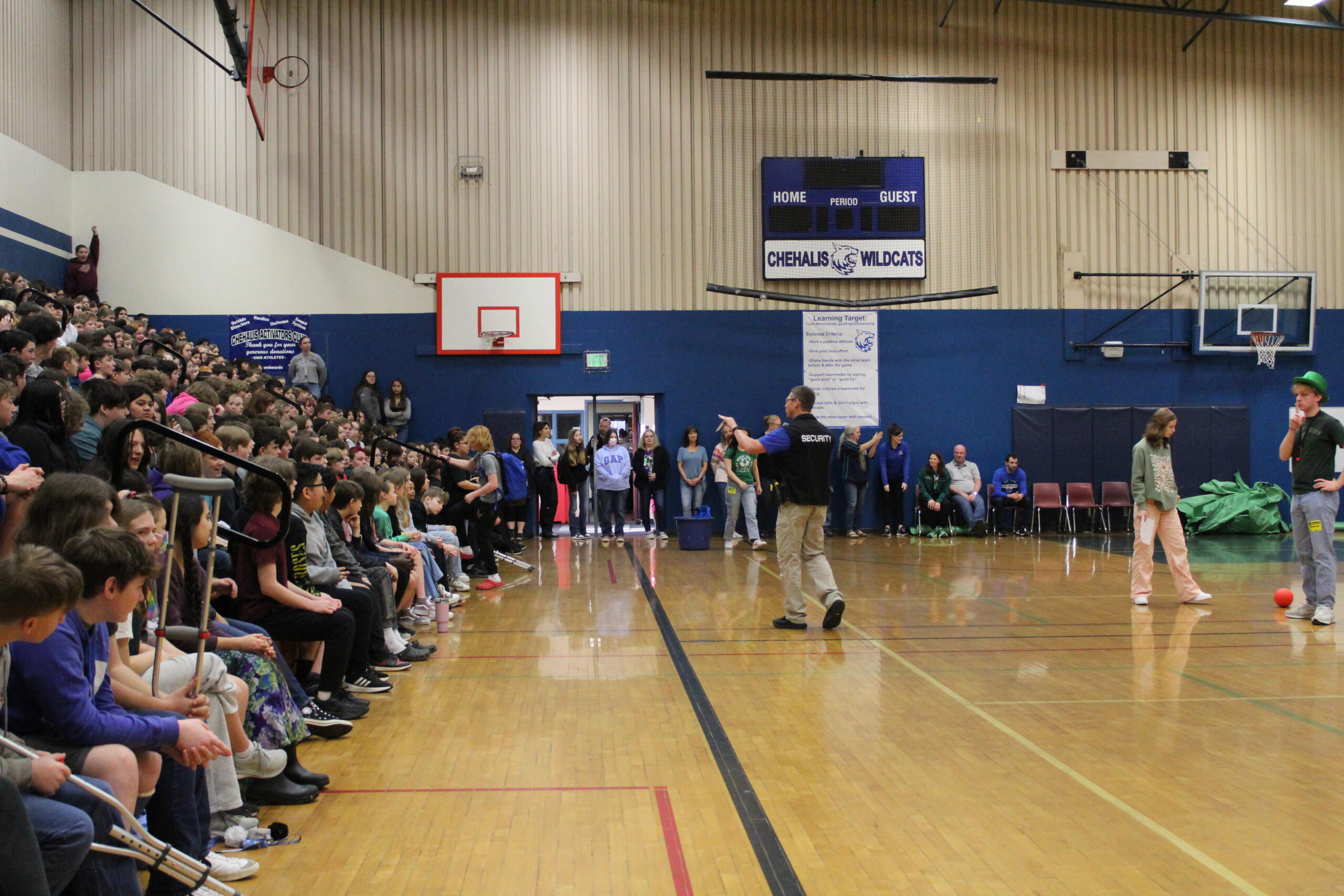Student Safety Is Our Priority
In the Chehalis School District, we take student safety seriously. Whether it’s crossing guards helping them get safely to school or staff undergoing training to be prepared in the case of an emergency, the social, emotional and physical safety of our students is a priority for all staff. Our safety initiatives are led by Security & Safety Officers Todd Thornburg and Troy Thornburg.
Chehalis School District’s Safety Measures
Two Security & Safety Officers who patrol our schools and plan safety measures
Navigate 360 ALICE Training for all staff and students
- More than 300 cameras throughout Chehalis School District property
- Collaboration with local law enforcement on training and strategies for deterring crime on campus
Offering anonymous reporting forms to encourage students to report illegal activities they witness
What You Can Do To Help
Make sure your family contact information is up to date in Skyward Family Access so we can reach you in an emergency. In the event of an emergency, the district will use ParentSquare to communicate with families, so make sure you have enabled messages from ParentSquare
Report any potential threats. If your student witnesses a threat at school or online, report it to our Security & Safety Officers or school administration
Read more about ALICE Training so you can understand how your student is prepared to stay safe at school
In the event of an emergency, do not come to the school or attempt to pick your student up early. Wait for official Chehalis School District communication through ParentSquare for information and instructions.
For questions about disciplinary policies:
Helpful Links

More Safety Information
Tall Cop – Helpful safety information for parents
Cyber Safety Cop – Digital citizenship and safety information for parents and students
The District is committed to a safe and civil educational environment for all students, employees, parents/legal guardians, volunteers and patrons that is free from harassment, intimidation or bullying. “Harassment, intimidation or bullying” means any intentional written message or image – including those that are electronically transmitted – verbal, or physical act, including but not limited to one shown to be motivated by race, color, religion, ancestry, national origin, gender, sexual orientation including gender expression or identity, or mental or physical disability, or other distinguishing characteristics, when an act:
• Physically harms a student or damages the student’s property.
• Has the effect of substantially interfering with a student’s education.
• Is so severe, persistent, or pervasive that it creates an intimidating or threatening educational environment.
• Has the effect of substantially disrupting the orderly operation of the school.
Nothing in this section requires the affected student to actually possess a characteristic that is a basis for the harassment, intimidation, or bullying.
“Other distinguishing characteristics” can include but are not limited to: physical appearance, clothing or other apparel, socioeconomic status, and weight.
“Intentional acts” refers to the individual’s choice to engage in the act rather than the ultimate impact of the action(s).
This policy is not intended to prohibit expression of religious, philosophical, or political views, provided that the expression does not substantially disrupt the educational environment. Many behaviors that do not rise to the level of harassment, intimidation or bullying may still be prohibited by other district policies or building, classroom, or program rules.
The District will consider the frequency of incidents, developmental age of the student, and severity of the conduct in determining intervention strategies. Interventions will range from counseling, correcting behavior and discipline, to law enforcement referrals.
It is also a violation of District policy to knowingly report false allegations of harassment, intimidation, and bullying. Students or employees will not be disciplined for making a report in good faith. However, persons found to knowingly report or corroborate false allegations will be subject to appropriate discipline.
Compliance Officer:
Trisha Smith, Assistant Superintendent
310 SW 16th Street, Chehalis, WA 98532
(360) 807-7200
The superintendent is authorized to direct the implementation of procedures addressing the elements of this policy.
In order to ensure respect and prevent harm, it is a violation of district policy for a student to be harassed, intimidated, or bullied by others in the school community, at school sponsored events, or when such actions create a substantial disruption to the educational process. The school community includes all students, school employees, school board members, contractors, unpaid volunteers, families, patrons, and other visitors. Student(s) will not be harassed because of their race, color, religion, ancestry, national origin, gender, sexual orientation, including gender expression or identity, mental or physical disability, or other distinguishing characteristics.
Any school staff who observes, overhears, or otherwise witnesses harassment, intimidation or bullying or to whom such actions have been reported must take prompt and appropriate action to stop the harassment and to prevent its reoccurrence.
Harassment, intimidation or bullying is an intentional electronic, written, verbal, or physical act that:
• Physically harms a student or damages the student’s property.
• Has the effect of substantially interfering with a student’s education.
• Is so severe, persistent, or pervasive that it creates an intimidating or threatening educational environment.
• Has the effect of substantially disrupting the orderly operation of the school.
Conduct that is “substantially interfering with a student’s education” will be determined by considering a targeted student’s grades, attendance, demeanor, interaction with peers, participation in activities, and other indicators.
Conduct that may rise to the level of harassment, intimidation and bullying may take many forms, including, but not limited to: slurs, rumors, jokes, innuendoes, demeaning comments, drawings, cartoons, pranks, ostracism, physical attacks or threats, gestures, or acts relating to an individual or group whether electronic, written, oral, or physically transmitted messages or images. There is no requirement that the targeted student actually possess the characteristic that is the basis for the harassment, intimidation or bullying.
Incident Reporting Form may be used by students, families, or staff to report incidents of harassment, intimidation or bullying.
Retaliation is when an aggressor harasses, intimidates, or bullies a student who has reported incidents of bullying.
Staff includes, but is not limited to, educators, administrators, counselors, school nurses, cafeteria workers, custodians, bus drivers, athletic coaches, advisors to extracurricular activities, classified staff, substitute and temporary teachers, volunteers, or paraprofessionals (both employees and contractors).
Targeted Student is a student against whom harassment, intimidation or bullying has allegedly been perpetrated.
At least four Washington laws may apply to harassment or discrimination:
• RCW 28A.300.285 – Harassment, Intimidation and Bullying
• RCW 28A.640.020 – Sexual Harassment
• RCW 28A.642 – Prohibition of Discrimination in Public Schools
• RCW 49.60.010 – The Law Against Discrimination
The district will ensure its compliance with all state laws regarding harassment, intimidation or bullying. Nothing in this procedure prevents a student, parent/guardian, school or district from taking action to remediate harassment or discrimination based on a person’s gender or membership in a legally protected class under local, state, or federal law.
In each school and on the district’s website the district will prominently post information on reporting harassment, intimidation and bullying; the name and contact information for making a report to a school administrator; and the name and contact information for the district compliance officer. The district’s policy and procedure will be available in each school.
Annually, the superintendent will ensure that a statement summarizing the policy and procedure is provided in student, staff, volunteer, and parent handbooks, is available in school and district offices and/or hallways, or is posted on the district’s website.
Additional distribution of the policy and procedure is subject to the requirements of Washington Administrative Code 392-400-226.
2. Education
Annually students will receive age-appropriate information on the recognition and prevention of harassment, intimidation or bullying at student orientation sessions and on other appropriate occasions. The information will include a copy of the Incident Reporting Form or a link to a web-based form.
3. Training
Staff will receive annual training on the school district’s policy and procedure, including staff roles and responsibilities, how to monitor common areas and the use of the district’s Incident Reporting Form.
4. Prevention Strategies
The district will implement a range of prevention strategies including individual, classroom, school, and district-level approaches.
Whenever possible, the district will implement evidence-based prevention programs that are designed to increase social competency, improve school climate, and eliminate harassment, intimidation and bullying in schools.
1. Provide support and assistance to the principal or designee in resolving complaints.
2. Receive copies of all Incident Reporting Forms including verfication of notification to parents providing the outcomes of investigations.
3. Be familiar with the use of the student information system. The compliance officer may use this information to identify patterns of behavior and areas of concern.
4. Ensure implementation of the policy and procedure by overseeing the investigative processes, including ensuring that investigations are prompt, impartial, and thorough.
5. Assess the training needs of staff and students to ensure successful implementation throughout the district, and ensure staff receive annual fall training.
6. Provide the OSPI School Safety Center with notification of policy or procedure updates or changes.
7. In cases where, despite school efforts, a targeted student experiences harassment, intimidation or bullying that threatens the student’s health and safety, the compliance officer will facilitate a meeting between district staff and the child’s parents/guardians to develop a safety plan to protect the student. A sample student safety plan is available on the OSPI website: www.k12.wa.us/SafetyCenter/default.aspx.
In order to protect a targeted student from retaliation, a student need not reveal his identity on an Incident Reporting Form. The form may be filed anonymously, confidentially, or the student may choose to disclose his or her identity (non-confidential).
Status of Reporter
a. Anonymous
Individuals may file a report without revealing their identity. No disciplinary action will be taken against an alleged aggressor based solely on an anonymous report. Schools may identify complaint boxes or develop other methods for receiving anonymous, unsigned reports. Possible responses to an anonymous report include enhanced monitoring of specific locations at certain times of day or increased monitoring of specific students or staff. (Example: An unsigned Incident Reporting Form dropped on a teacher’s desk led to the increased monitoring of the boys’ locker room in 5th period.)
b. Confidential
Individuals may ask that their identities be kept secret from the accused and other students. Like anonymous reports, no disciplinary action will be taken against an alleged aggressor based solely on a confidential report. (Example: A student tells a playground supervisor about a classmate being bullied but asks that nobody know who reported the incident. The supervisor says, “I won’t be able to discipline the bullies unless you or someone else who saw it is willing to let me use their names, but I can start hanging out near the basketball court, if that would help.”)
c. Non-confidential
Individuals may agree to file a report non-confidentially. Complainants agreeing to make their complaint non-confidential will be informed that due process requirements may require that the district release all of the information that it has regarding the complaint to any individuals involved in the incident, but that even then, information will still be restricted to those with a need to know, both during and after the investigation. The district will, however, fully implement the anti-retaliation provision of this policy and procedure to protect complainants and witnesses.
Step 2: Receiving an Incident Reporting Form
All staff are responsible for receiving oral and written reports. Whenever possible staff who initially receive an oral or written report of harassment, intimidation or bullying shall attempt to resolve the incident immediately. If the incident is resolved to the satisfaction of the parties involved, or if the incident does not meet the definition of harassment, intimidation or bullying, no further action may be necessary under this procedure.
All reports of unresolved, severe, or persistent harassment, intimidation or bullying will be recorded on a district Incident Reporting Form and submitted to the principal or designee, unless the principal or designee is the subject of the complaint.
Step 3: Investigations of Unresolved, Severe, or Persistent Harassment, Intimidation and Bullying
All reports of unresolved, severe, or persistent harassment, intimidation or bullying will be investigated with reasonable promptness. Any student may have a trusted adult with them throughout the report and investigation process.
a. Upon receipt of the Incident Reporting Form that alleges unresolved, severe, or persistent harassment, intimidation or bullying, the school or district designee will begin the investigation. If there is potential for clear and immediate physical harm to the complainant, the district will immediately contact law enforcement and inform the parent/guardian.
b. During the course of the investigation, the district will take reasonable measures to ensure that no further incidents of harassment, intimidation or bullying occur between the complainant and the alleged aggressor. If necessary, the district will implement a safety plan for the student(s) involved. The plan may include changing seating arrangements for the complainant and/or the alleged aggressor in the classroom, at lunch, or on the bus; identifying a staff member who will act as a safe person for the complainant; altering the alleged aggressor’s schedule and access to the complainant, and other measures.
c. Within two (2) school days after receiving the Incident Reporting Form, the school designee will notify the families of the students involved that a complaint was received and direct the families to the district’s policy and procedure on harassment, intimidation and bullying.
d. In rare cases, where after consultation with the student and appropriate staff (such as a psychologist, counselor, or social worker) the district has evidence that it would threaten the health and safety of the complainant or the alleged aggressor to involve his or her parent/guardian, the district may initially refrain from contacting the parent/guardian in its investigation of harassment, intimidation and bullying. If professional school personnel suspect that a student is subject to abuse and neglect, they must follow district policy for reporting suspected cases to Child Protective Services.
e. The investigation shall include, at a minimum:
• An interview with the complainant;
• An interview with the alleged aggressor;
• A review of any previous complaints involving either the complainant or the alleged aggressor; and
• Interviews with other students or staff members who may have knowledge of the alleged incident.
f. The principal or designee may determine that other steps must be taken before the investigation is complete.
g. The investigation will be completed as soon as practicable but generally no later than five (5) school days from the initial complaint or report. If more time is needed to complete an investigation, the district will provide the parent/guardian and/or the student with updates.
h. No later than two (2) school days after the investigation has been completed, the principal or designee shall respond to the parent/guardian of the complainant and the alleged aggressor stating:
• The results of the investigation.
• Whether the allegations were found to be factual.
• Whether there was a violation of policy.
• The process for the complainant to file an appeal if the complainant disagrees with results.
Because of the legal requirement regarding the confidentiality of student records, the principal or designee may not be able to report specific information to the targeted student’s parent/guardian about any disciplinary action taken unless it involves a directive that the targeted student must be aware of in order to report violations.
If a district chooses to contact the parent/guardian by letter, the letter will be mailed to the parent/guardian of the complainant and alleged aggressor by United States Postal Service unless it is determined, after consultation with the student and appropriate staff (psychologist, counselor, social worker) that it could endanger the complainant or the alleged aggressor to involve his or her family. If professional school personnel suspect that a student is subject to abuse or neglect, as mandatory reporters they must follow district policy for reporting suspected cases to Child Protective Services.
If the incident cannot be resolved at the school level, the principal or designee shall request assistance from the district.
Step 4: Corrective Measures for the Aggressor
After completion of the investigation, the school or district designee will institute any corrective measures necessary. Corrective measures will be instituted as quickly as possible, but in no event more than five (5) school days after contact has been made to the families or guardians regarding the outcome of the investigation. Corrective measures that involve student discipline will be implemented according to district policy 3241, Classroom Management, Corrective Actions or Punishment. If the accused aggressor is appealing the imposition of discipline, the district may be prevented by due process considerations or a lawful order from imposing the discipline until the appeal process is concluded.
If in an investigation a principal or principal’s designee found that a student knowingly made a false allegation of harassment, intimidation or bullying, that student may be subject to corrective measures, including discipline.
Step 5: Targeted Student’s Right to Appeal
1. If the complainant or parent/guardian is dissatisfied with the results of the investigation, they may appeal to the superintendent or his or her designee by filing a written notice of appeal within five (5) school days of receiving notification of outcome. The superintendent or his or her designee will review the investigative report and issue a written decision on the merits of the appeal within five (5) school days of receiving the notice of appeal.
2. If the targeted student remains dissatisfied after the initial appeal to the superintendent, the student may appeal to the school board by filing a written notice of appeal with the secretary of the school board on or before the fifth (5) school day following the date upon which the complainant received the superintendent’s written decision.
3. An appeal before the school board or disciplinary appeal council must be heard on or before the tenth (10th) school day following the filing of the written notice of appeal to the school board. The school board or disciplinary appeal council will review the record and render a written decision on the merits of the appeal on or before the fifth (5th) school day following the termination of the hearing, and shall provide a copy to all parties involved. The board or council’s decision will be the final district decision.
Step 6: Discipline/Corrective Action
The district will take prompt and equitable corrective measures within its authority on findings of harassment, intimidation or bullying. Depending on the severity of the conduct, corrective measures may include counseling, education, discipline, and/or referral to law enforcement.
Corrective measures for a student who commits an act of harassment, intimidation or bullying will be varied and graded according to the nature of the behavior, the developmental age of the student, or the student’s history of problem behaviors and performance. Corrective measures that involve student discipline will be implemented according to district policy 3241, Classroom Management, Corrective Actions or Punishment.
If the conduct was of a public nature or involved groups of students or bystanders, the district should strongly consider schoolwide training or other activities to address the incident.
If staff have been found to be in violation of this policy and procedure, school districts may impose employment disciplinary action, up to and including termination. If a certificated educator is found to have committed a violation of WAC 181-87, commonly called the Code of Conduct for Professional Educators, OSPI’s Office of Professional Practices may propose disciplinary action on a certificate, up to and including revocation. Contractor violations of this policy may include the loss of contracts.
Step 7: Support for the Targeted Student
Persons found to have been subjected to harassment, intimidation or bullying will have appropriate district support services made available to them, and the adverse impact of the harassment on the student shall be addressed and remedied as appropriate.





Get Social With Us!